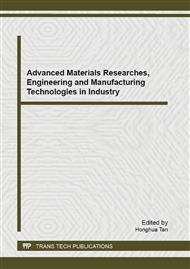[1]
Hirokawa Y. and Tanaka T. J Chem Phys. Vol. 12 (1984), p.6379.
Google Scholar
[2]
Chen G. H. and Hoffman A. S. Nature. Vol. 373 (1995), p.49.
Google Scholar
[3]
Lu X. Q., Zhai M. L., Li J. Q. and Ha H. F. Radiat Phys Chem. Vol. 57 (2003), p.477.
Google Scholar
[4]
Masci G., Bontempo D. and Crescenzi V. Polymer. Vol. 20 (2002), p.5587.
Google Scholar
[5]
Kim S. J., Park S. J. and Kim S. I. Reactive & Functional Polymers. Vol. 55 (2003), p.61.
Google Scholar
[6]
Zhang X. Z., Wu D. Q. and Chu C. C. Biomaterials. Vol. 19 (2004), p.4719.
Google Scholar
[7]
Chen J. P. and Chiu S. H. Enzyme and Microbial Technology. Vol. 5-6 (2000), p.359.
Google Scholar
[8]
Lehto J., Vaaramaa K., Vesteinen E. and Tenhu H. J Appl polym Sci. Vol. 3 (1998), p.355.
Google Scholar
[9]
Zhai M. L., Liu N., Li J., Yi M., Li J. Q. and Ha H. F. Radiat Phys Chem. Vol. 3-6(2000), p.481.
Google Scholar
[10]
Dong L. C. and Hoffman A. S. J Controlled Release. Vol. 2 (1991), p.141.
Google Scholar
[11]
Xue W. and Hamley I. W. Polymer. Vol. 43 (2002), p.3069.
Google Scholar
[12]
Senel S., Isikyuruksoy B., Clcek H. and Tuncel A. J Appl polym Sci. Vol. 64 (1997), p.1775.
Google Scholar
[13]
Zhang X. Z., Wu D. Q. and Chu C. C. Biomaterials. Vol. 19 (2004), p.3793.
Google Scholar
[14]
Yoo M. K., Sung Y. K. and Cho C. S. Polymer. Vol. 41 (2000), p.5713.
Google Scholar
[15]
Feil H., Bae Y. H., Feijen J. and Kim S. W. Macromolecules. Vol. 10 (1993), p.2496.
Google Scholar
[16]
Schild H. G. and Tirrell D. A. J Phys Chem. Vol. 94 (1990), p.4352.
Google Scholar
[17]
Park T. G. and Hoffman A. S. Macromolecules. Vol. 26 (1993), p.5045.
Google Scholar
[18]
Liu X. H., Wang X. G. and Liu D. S. Acta Polymeric Sinica. Vol. 3 (2002), p.358.
Google Scholar
[19]
Pei Y., Chen J., Yang L. M., Shi L. L., Tao Q., Hui B. J. and Li J. Journal of Biomaterial Science, Polymer Edition. Vol. 5 (2004), p.585.
Google Scholar
[20]
Sandler S. R. and Karo W. Polymer Synthesis (Academic, New York, 1977), Vol. Ⅱ. P. 271.
Google Scholar
[21]
Tanaka T., Fillmore D., and Sun S. J Phys Rev Lett. Vol. 20 (1980), p.1636.
Google Scholar


